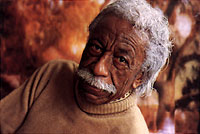 Gordon
Parks:
Gordon
Parks: Gordon
Parks:
Gordon
Parks:
Photography as his weapon
Written by: Danny Moloshok, Universtiy of Michigan 12/2002
Photo Source: http://pdn-pix.com/legends/parks/bio_set.shtml, © Johanna Fiore
This research paper was written for a Communications Class at the University of Michigan and is not considered a part of the public realm and in no way can be reprinted in part or whole without the permission of the author.
A photograph is worth a thousand words, but to Gordon Parks, it means so much more. Gordon Parks is an exceptional photojournalist who began to capture moments of the African American community telling a story through these thousand-word images. Gordon Parks used his art form to comment on the feeling of the black community. He at one time was a staff photographer for Life magazine were he would cover stories such as those on Black Muslims and the feelings in black neighborhoods. (Willis-Thomas) By continuing the framework that the black media created for social commentary, Gordon Parks used photography as his “choice of weapon” against race discrimination, bigotry, and poverty. (Parks 1966)
The first
newspaper published in America was the Boston
New-Letter on April 24, 1704 by John Campell in Boston, Massachusetts. This Boston
New-Letter contained information from London, England pertaining to
politics. There were no photographs in this issue, as photographic technology
did not exist yet. The first
photograph did not exist until 1822 when Nicéphore Niépce took an eight hour
exposure of the roof tops outside his home. This photo was not even close to
being the quality needed for a newspaper. But as the technology of photography
progressed, the desire to illustrate news stories came into existence.
Throughout the years it became easier and easier to illustrate a story with a
photograph. Cameras became lighter and more portable as film became easier to
use.
Photographs began to appear in newspapers in the early 1900s. By this point in the media there was a distinct difference between the mainstream press and the Black Press. The mainstream press after emancipation did not sufficiently cover events pertaining to African-American culture. Thus, a black press emerged to combat the shortcomings of the mainstream press. The Freedom’s Journal was the first Black publication that was owned and operated by African Americans. It was established at the same time as the abolition movement in order to combat the mainstream press and “counter racist commentary published in the mainstream press”(PBS online). Once photos became to appear within both the mainstream press and the black press, they were distinctly different. In the black press photos would not only have a deep meaning to them like the mainstream press, but also would strive to prove a point beyond the obvious to editorialize on different social injustices. Photography is an art that allows an individual to express their deepest thoughts and feelings. Even if a photographer does not purposely illustrate their feelings, unconsciously the photographer expresses their thoughts and Gordon Parks is an exceptional example of just that sort of photographer.
Parks always portrayed America in a cold stark fashion. He commented on “social injustice, poverty and racism” through his photographs. The photographs described within this text are quintessential examples of how Gordon Parks was able to attack society with his camera instead of weapons and war. Parks proclaimed in 2002 that “[he] picked up a camera because it was [his] choice of weapons against what [he] hated most about the world, including racism, intolerance and poverty”(Kilgannon 2002).
Gordon Parks grew up on a dirt farm in Fort Scott, Kansas. When he was fifteen years old his mother died and he was shipped off to his sister’s house in Minnesota. Parks “suffered all the intolerance as a black kid growing up in Kansas”. Just because of his color, he could not even go to the corner store to get an ice cream cone. (Parks within Harris 1998) While he was a child many of his close friends died due to violence. Four of them were shot to death and he witnesses two women knifing each other to death in front of a poll hall. Parks felt like death was following him and he had to escape it. He worked many jobs including a piano player in a brothel and he was a railroad waiter where he was first exposed to photographs in magazines left by rail customers. Many were fashion photographs that showed beautiful women in the latest clothing and accessories, yet the photos from the Farm Security Administration intrigued him the most. The Farm Security Administration, or FSA, was created to present awareness of the plight of the rural areas during the depression. “When Roosevelt gave [the United States] the FSA program, [he] saw how Walker Evans, Dorthea Lang…penetrated the south and the rural community…to help the farmers that were dispossessed. [Gordon Parks] decided then that [he] could use the camera as a tool against discrimination and poverty that [he had] suffered”(Parks via Eastman 1990).
These FSA images gave Parks the motivation to being photography. He knew that fashion photography would probably earn him more money than photos of poverty, so he began as a fashion photographer for a small clothing store to save money for a better camera and better equipment. He did however, still photograph poverty including images from the black ghetto in Chicago. This persistence is where Gordon Parks became a part of the Black Press. Gordon Parks had an agenda he wished to accomplish. He had to make money to survive in the beginning; and thus at first had to curb his agenda for a little while in order to achieve them in the long run.
Gordon parks used his photography to editorialize on the state of African Americans within America. Even though his photographs appeared as a part of the mainstream press while working for LIFE magazine from 1948-1972, Parks was still representing the black press. (Kilgannon 2002) His views and ideas that he chose to convey urged the white community to accept the black community and look beyond their racial profiles. While the black press was owned and operated by African Americans, it still had a white target audience. In order to achieve equality for African Americans the Black Press had to create awareness within the black community as well as reach beyond its community to the mainstream public. Without recognition from the oppressors, success could not have been achieved. One could argue that Gordon Parks had the advantage to reach the white population, as he was an insider at a mainstream publication while acting with an agenda analogous to the black press. Parks knew that no one would pay him to photograph poverty early in his career, but he knew that some day these photographs would be necessary to publish. He waited his time to uphold socially responsible journalism as was so widely preached through the black press. Parks never really said that he was a part of the black press, but he did mention “that [he] felt suppose[dly] without knowing it [that] this was a way [he] could express what [he] liked or disliked about [his] life, about America…which was lending [him] a lot of intolerances at that time” because of his race. (Parks via Eastman 1990)
Gordon Parks named his first professional photograph and one of his most famous photographs, American Gothic. Parks created this photo as a direct influence of his experiences earlier that same day in 1942. On his first day working for the FSA, Parks’ mentor, Roy Stryker, told him to buy a coat at the store, then get some food, relax and watch a movie. Parks thought this was extremely nice of his editor to allow him to get acquainted with the town and take his first day to relax. This was not Stryker’s intention. At the department store, Parks was refused service and told as soon as he got off the elevator that they did not have his size. After being belittled by the store’s manager and arguing, the manager and arguing, he realized he was being treated this way because he was black. The manager finally offered him a coat but Parks took a stand affirming that now would not wear one of their coats if they gave it to him. He told them, “you’re going to hear from me, one day you’re going to hear from me”(Parks via Eastman 1990). This was true as Gordon Parks’ photojournalism ended up indirectly targeting this social injustice that he faced in the department store. Parks went on to have some lunch and then to go to the movies, yet he was refused services at both this places as well. These events spurred the feelings inside of him that would give rise to the editorializing though his photographs. Parks later admitted that “[he] was rather naïve” and “expected somehow or another that Washington D.C. …would be the wonderful place for a young American to go no matter what color”(Parks via Eastman 1990) When he came back to the office and told Stryker what he had experienced, Stryker was not surprised as he told Parks, “ok you now know what you are up against” while Parks questioned, “what do I do about it?” Stryker could only inquire the young Gordon Parks, “what did you bring that damn camera down here for?”(Parks via Eastman 1990).
Gordon Parks’
first image is of a black washwoman, Ella Watson, holding a broom in one hand
and a mop in another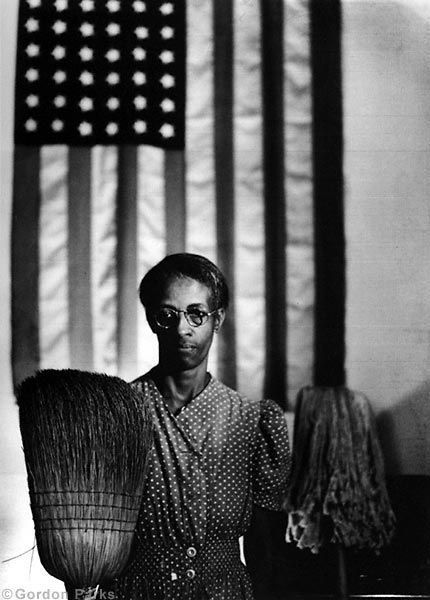 r
with the American Flag in the background. The woman has a look of sorrow and
seriousness on her face. He took this photo to begin editorializing on the
poverty and lack of respect that as he shows here, many blacks were forced into.
As a child in school, Parks was told that he had no chance of being anything
important in the world and that his studies were useless. (Parks within Harris
1998) Parks connected with Watson in this sense as she was an educated girl and
it hurt him that she had gotten caught up in washing floors instead of using her
intellect in a more productive manner. (Parks via Eastman 1990) After about an
hour of discussing her lifetime of despair, Parks asked Watson to keep thinking
what she had just told him while he took her picture. With the American flag in
the background and the stalk look on her face, Park’s boss was moved so much
from the photo, he was afraid they would all be fired because of its possible to
interpret as an indictment of America. Nonetheless he loved the photo and he
kept it on file anyhow and it ended up running on the front page of The Washington Post. (Video from: http://pdn-pix.com/legends/parks/mainframeset1end.shtml)
r
with the American Flag in the background. The woman has a look of sorrow and
seriousness on her face. He took this photo to begin editorializing on the
poverty and lack of respect that as he shows here, many blacks were forced into.
As a child in school, Parks was told that he had no chance of being anything
important in the world and that his studies were useless. (Parks within Harris
1998) Parks connected with Watson in this sense as she was an educated girl and
it hurt him that she had gotten caught up in washing floors instead of using her
intellect in a more productive manner. (Parks via Eastman 1990) After about an
hour of discussing her lifetime of despair, Parks asked Watson to keep thinking
what she had just told him while he took her picture. With the American flag in
the background and the stalk look on her face, Park’s boss was moved so much
from the photo, he was afraid they would all be fired because of its possible to
interpret as an indictment of America. Nonetheless he loved the photo and he
kept it on file anyhow and it ended up running on the front page of The Washington Post. (Video from: http://pdn-pix.com/legends/parks/mainframeset1end.shtml)
Many photographic elements here add to the story of the subject itself. The composition here is crucial. Parks placed Watson in front of the American flag, yet the flag does not overtake the whole background. This off balanced approach creates a sense of uneasiness while viewing the photo. The viewer would feel most comfortable if the flag was perfectly in the center painting a pretty backdrop behind the woman. Parks did not want the image to be a pretty picture; he wanted to create nervousness within the photo making it a stalk image. With the flag rising high above the subject, it gives a sense of control over the woman. This editorialization connects the control of Washington D.C., the center of America, that Parks felt earlier in the day with the life of the washwoman. His experiences left him striving to demonstrate and probe nonsensical racial resistance within America
Another
photograph, or in this case a photo essay, that Gordon Parks used to
editorialize was that of Flavio da Silvio. (Figure 2) Parks affirms that one 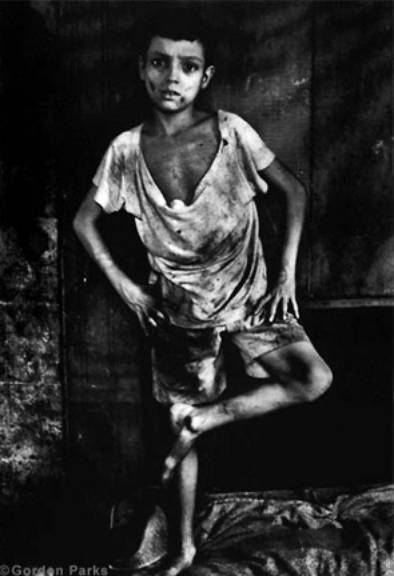 of
the “[s]tories that meant the most to [him] were the stories that involved
poverty stricken people”(Parks via Eastman 1990).Gordon Parks spent a long
time with Flavio while he wrote and photographed this young Brazilian boy with
his troubles of tuberculosis along with poverty in Rio de Janeiro.
Now, Parks reflects back on Flavio and how magnificent of a person he
was. Flavio knew he was going to die from his condition. He “didn’t care
about dying”, what he was most scared about was that his brothers and sisters
were going to be ok after he passed away. (Parks via Eastman 1990) Flavio had a
character [that would] outdo any character [Parks] knew throughout [his]
lifetime”. (Video from: http://pdn-pix.com/legends/parks/mainframeset1end.shtml).
of
the “[s]tories that meant the most to [him] were the stories that involved
poverty stricken people”(Parks via Eastman 1990).Gordon Parks spent a long
time with Flavio while he wrote and photographed this young Brazilian boy with
his troubles of tuberculosis along with poverty in Rio de Janeiro.
Now, Parks reflects back on Flavio and how magnificent of a person he
was. Flavio knew he was going to die from his condition. He “didn’t care
about dying”, what he was most scared about was that his brothers and sisters
were going to be ok after he passed away. (Parks via Eastman 1990) Flavio had a
character [that would] outdo any character [Parks] knew throughout [his]
lifetime”. (Video from: http://pdn-pix.com/legends/parks/mainframeset1end.shtml).
As a black man within the mainstream press, Parks practiced social responsible journalism just as the black press had. The people in America did not know about the plight of Brazilians just like Flavio, and thus it was necessary that truthful images from this area were given to the people. When the images reached the American public, there was an overwhelming amount of response. Parks received thirty thousand dollars with letters urging him to go back to Rio de Janeiro and save Flavio. Parks took this money along with more from LIFE magazine and brought Flavio back to America. Flavio was healed back to health in America and then sent back home to be with his family. He is now still living with three kids with one of them named Gordon. (Parks via Eastman 1990) Gordon Parks’ social responsible journalism called for change in society just like the Black Press did after the abolition of slavery. Although Parks did not consider himself a member of the black press, as he worked within the mainstream press, the goals of his art paralleled the aspirations of the black press.
Gordon Parks
would really get to know his subjects as was evident in how he connected with
Flavio. He would live with his subjects for a month so both him and the subjects
would feel comfortable with him taking photographs. Once instance of this was in
1967 when he lived with the Fontanelle Family in Harlem. What he wanted to do in
Harlem was to show “why black people were rioting in urban areas in
America”(Video from: pdn-pix.com/legends/parks/). Figure 3 is one of Parks’
images from his work with the 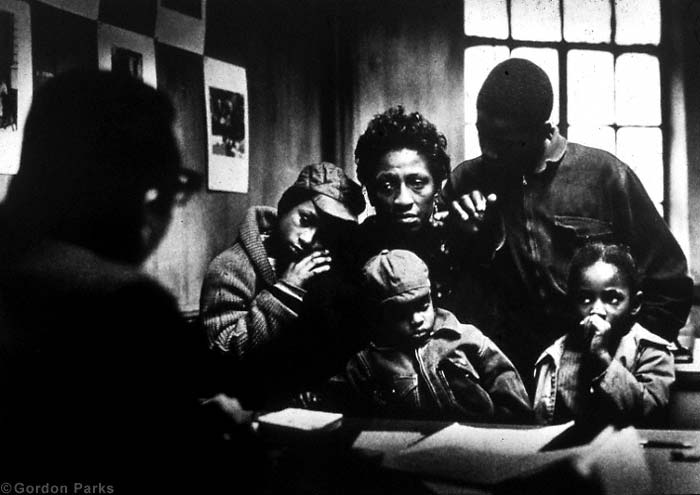 family.
Parks uses the contrast of light and dark shadows to make the image more
powerful. The family matriarch, Bessie Fontanelle, is clearly shown as the only
hope in the family as she stands in the middle of her family pleading to the
poverty board for help. It is crucial how Parks waited for the moment when the
father was engulfed in shadow with his head hanging low towards the mother,
leaving her as the last hope of the falling family. Also, the horror in the eyes
of the young girl and the worthlessness feelings in the other children’s body
language typify the feelings of the Family within a poverty stricken world where
they cannot even go to school in the winter because they have no clothes to
wear. This image beautifully embodies the exhausting emotions of Harlem blacks
that had
family.
Parks uses the contrast of light and dark shadows to make the image more
powerful. The family matriarch, Bessie Fontanelle, is clearly shown as the only
hope in the family as she stands in the middle of her family pleading to the
poverty board for help. It is crucial how Parks waited for the moment when the
father was engulfed in shadow with his head hanging low towards the mother,
leaving her as the last hope of the falling family. Also, the horror in the eyes
of the young girl and the worthlessness feelings in the other children’s body
language typify the feelings of the Family within a poverty stricken world where
they cannot even go to school in the winter because they have no clothes to
wear. This image beautifully embodies the exhausting emotions of Harlem blacks
that had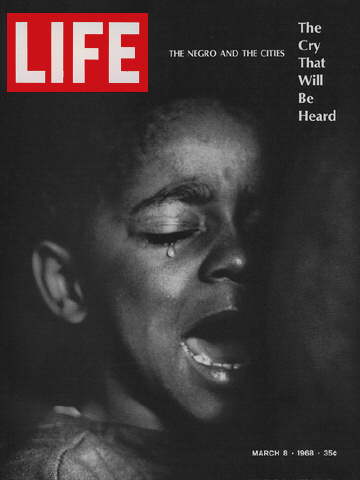 never been captured or communicated to the public before Parks’ work. Figure 4
is the cover of the issue that contained the photo essay on the Fontanelle
family. As a tear percolates through the eyelashes of the young girl, extreme
emotion is endless. Parks’ brilliance captured the one moment where the tear
is just about to fall down the face. Harsh shadows here again intensify the
subject and give the child’s emotions a daunting mood. The viewer feels as if
the child seems lost in a dark cold world, and this is indeed what Parks wanted
to convey. It seems like the child has his face pressed against someone’s
belly, perhaps receiving a hug, yet this fact is left unclear and raises
emotions in the viewer to an even higher level. Gordon Parks successfully
presented the mainstream press with key elements it was lacking. This one photo,
accompanied with others inside, cries out for help and awareness of the
heartbreaking black poverty that is explored in more depth within the
magazine’s pages. (Brookman 1998)
never been captured or communicated to the public before Parks’ work. Figure 4
is the cover of the issue that contained the photo essay on the Fontanelle
family. As a tear percolates through the eyelashes of the young girl, extreme
emotion is endless. Parks’ brilliance captured the one moment where the tear
is just about to fall down the face. Harsh shadows here again intensify the
subject and give the child’s emotions a daunting mood. The viewer feels as if
the child seems lost in a dark cold world, and this is indeed what Parks wanted
to convey. It seems like the child has his face pressed against someone’s
belly, perhaps receiving a hug, yet this fact is left unclear and raises
emotions in the viewer to an even higher level. Gordon Parks successfully
presented the mainstream press with key elements it was lacking. This one photo,
accompanied with others inside, cries out for help and awareness of the
heartbreaking black poverty that is explored in more depth within the
magazine’s pages. (Brookman 1998)
Gordon remarks that it was difficult to not give the family food, money in order to ease their situation. He wished to show the world what families in Harlem suffered through so people could understand their pain and aggravation. If he had helped them out at first he would have lost his story on this family that represented the sadness and poverty within the black community. He knew that documenting the poverty would prove to be more beneficial than playing god to one family. Gordon remarks that by while he practices this socially responsible journalism “you pray and hope that you can get your story over as quickly as possible, and that there will be a [positive] response from the public.”(Video from: http://pdn-pix.com/legends/parks/mainframeset2.shtml)
Gordon
embodied the ideology of the Black Press through revolutionizing the
mainstream press rather than becoming a photographer for a traditional black
newspaper or magazine. In 1948 Parks followed around a sixteen-year-old Harlem
gang lea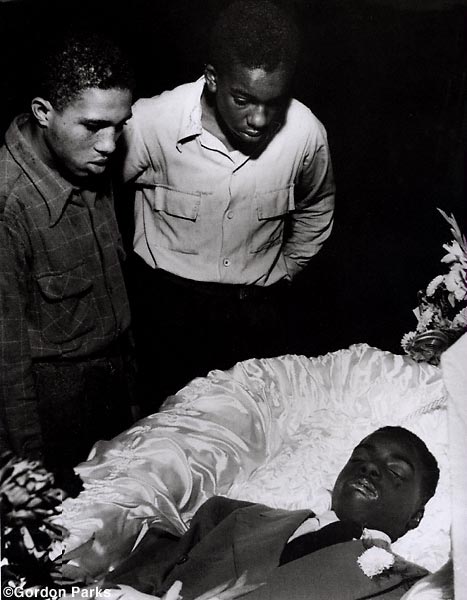 der
Red Jackson and documented his life as a gang leader of the Midtowners. In
figure 5 Red Jackson, in the darker shirt, is peering into the casket looking
a fellow gang member that had been murdered by another gang a few days before.
After the funeral, Parks along with the other gang members had to run away
from other gangs attacking them. They found refuge in a hide out in Harlem and
as they were hiding out, Parks captured the image of Red Jackson protecting
the hide out. As seen in figure 6, Jackson peers out the window after he broke
the glass. His arms seem crossed and Parks reveals that Jackson was holding a
forty-five automatic in his shirt in case they were attacked. Again, Parks
uses shadows and highlights to show the viewer the only parts of the moment he
feels is important. The light is a harsh sidelight outlining the facial
features of the gang leader and showing extreme detail i
der
Red Jackson and documented his life as a gang leader of the Midtowners. In
figure 5 Red Jackson, in the darker shirt, is peering into the casket looking
a fellow gang member that had been murdered by another gang a few days before.
After the funeral, Parks along with the other gang members had to run away
from other gangs attacking them. They found refuge in a hide out in Harlem and
as they were hiding out, Parks captured the image of Red Jackson protecting
the hide out. As seen in figure 6, Jackson peers out the window after he broke
the glass. His arms seem crossed and Parks reveals that Jackson was holding a
forty-five automatic in his shirt in case they were attacked. Again, Parks
uses shadows and highlights to show the viewer the only parts of the moment he
feels is important. The light is a harsh sidelight outlining the facial
features of the gang leader and showing extreme detail i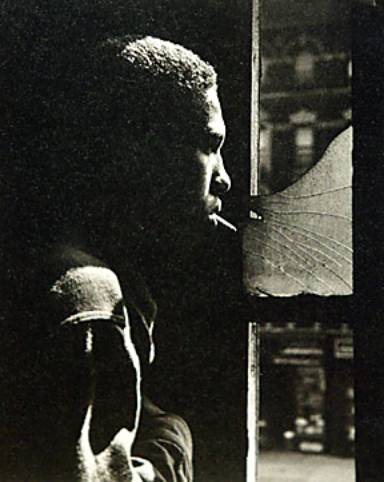 n
the broken glass window. Without the detail of the broken glass, the image
would not be as powerful. This broken glass along with the weak lip closure
barely holding the cigarette, illustrates the “look out” position that Red
Jackson was not only taking at that particular moment, but probably assumed
frequently. (Video From: http://pdn-pix.com/legends/parks/mainframeset.shtml)(Tobin
2000 via PDN) (Parks, within Harris 1998) Gordon Parks used his identity as a
black person to give the public a side of the story they had never seen
before. He was able to befriend Red Jackson as a black man and Jackson was
more willing to trust him to tag along with the gang. A white photojournalist
at this time in American society would never had been able to gain the trust
of Red Jackson. In 1948 when Parks approached his editors at LIFE magazine he
insisted on “saying something with [his] camera that none of the white
photographers could do, such as to penetrate a Harlem gang”(Parks, within
Harris 1998). (Tobin 2000 via PDN)
n
the broken glass window. Without the detail of the broken glass, the image
would not be as powerful. This broken glass along with the weak lip closure
barely holding the cigarette, illustrates the “look out” position that Red
Jackson was not only taking at that particular moment, but probably assumed
frequently. (Video From: http://pdn-pix.com/legends/parks/mainframeset.shtml)(Tobin
2000 via PDN) (Parks, within Harris 1998) Gordon Parks used his identity as a
black person to give the public a side of the story they had never seen
before. He was able to befriend Red Jackson as a black man and Jackson was
more willing to trust him to tag along with the gang. A white photojournalist
at this time in American society would never had been able to gain the trust
of Red Jackson. In 1948 when Parks approached his editors at LIFE magazine he
insisted on “saying something with [his] camera that none of the white
photographers could do, such as to penetrate a Harlem gang”(Parks, within
Harris 1998). (Tobin 2000 via PDN)
In the sixties, Gordon Parks continued to demonstrate socially responsible journalism by showing the truth and feeling behind the black militants and the black Muslims. The militants of the time did not trust LIFE magazine since they seemed to represent the mainstream voice, yet Gordon Parks was able to break this negative sentiment. Through covering the black militant movement, the militants were able to get their voices out in the open and Gordon Parks was the bridging gap between the black community and the mainstream press and public. Gordon remarks that “what they wanted to say, they said it…and [he] served as…a [while bringing] a lot of understanding” to LIFE magazine and the community. (Parks via Brard 1993)
LIFE
magazine had been trying to cover the black militancy for over three years but
failed with white photographers, so they went to Parks hoping that he could
perhaps gain the access that a photoessay would require. Elijah Muhammad, the
leader of the Nation of Islam at the time, granted Parks access to mosques and
rallies. Parks even grew close to Malcom X, where as Parks became the
godfather to his daughter. (Tobin 2000) One of the noticeably strong
photographs that Parks captured is that of Ethe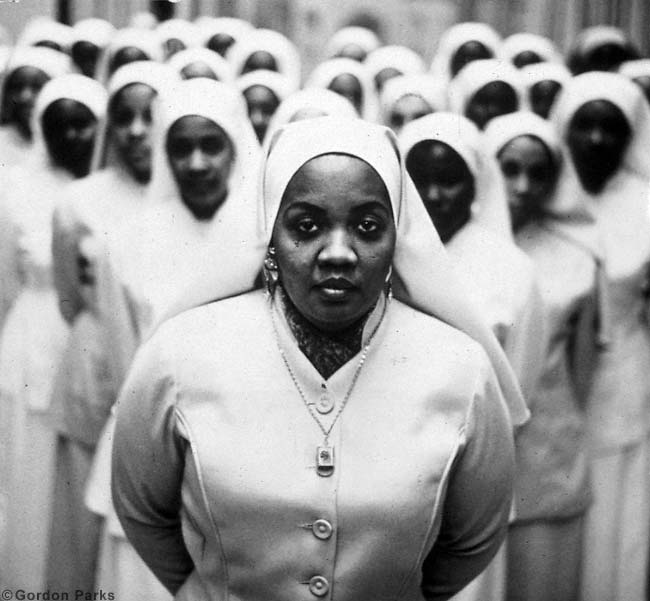 l
Shariff, the daughter of Elijah Muhammad. She was the leader of the women’s
corps of the Black Muslims. In the image, shown in figure 7, places Shariff in
the middle of the photo in order to make it clear that she was the leader of
the women’s corps of the Black. Parks captures her at the moment where she
presents a serious gaze straight towards the viewer, almost through the
camera. The audience feels her seriousness with the authenticity of what she
and the rest of her followers stand for. The image is perfectly balanced and
by using a longer focal length lens, Parks was able to visually ‘stack’ or
‘compress’ the women behind her to present the sense of unity behind their
leader. (Mitchell 2002) The contrast here between the white and black of the
dresses with the skin tones creates a strong impact on the viewer. At this
time period, blacks where not considered equals and to see them dressed in all
white as if they were catholic nuns, presents a shock value to the audience
and challenges them to reconsider their stereotypes.
l
Shariff, the daughter of Elijah Muhammad. She was the leader of the women’s
corps of the Black Muslims. In the image, shown in figure 7, places Shariff in
the middle of the photo in order to make it clear that she was the leader of
the women’s corps of the Black. Parks captures her at the moment where she
presents a serious gaze straight towards the viewer, almost through the
camera. The audience feels her seriousness with the authenticity of what she
and the rest of her followers stand for. The image is perfectly balanced and
by using a longer focal length lens, Parks was able to visually ‘stack’ or
‘compress’ the women behind her to present the sense of unity behind their
leader. (Mitchell 2002) The contrast here between the white and black of the
dresses with the skin tones creates a strong impact on the viewer. At this
time period, blacks where not considered equals and to see them dressed in all
white as if they were catholic nuns, presents a shock value to the audience
and challenges them to reconsider their stereotypes.
Through
his images, Gordon Parks has presented the public with what the mainstream
press faulted to show until he chose to use photography as his weapon
paralleling the endeavors of the Black Press. Gordon Parks was able to bring
the black press mentality to the mainstream press. Parks has gone beyond just
photography in battling injustice in the world. He directed films such as his
autobiographical piece The Learning Tree
and the recently recreated Shaft where
his messages were slightly different than his photographs, yet his agenda
similar. He reaffirmed that the motivation behind Shaft was “to give blacks a positive role model…in this case a
charismatic detective” in order to combat the lingering social
discriminations. (Parks via MacNeil 1999). In addition to movies, Parks also
has composed a dozen major musicals, begun painting and created a ballet.
(Briggs 1997). Gordon Parks born on November 30, 1912, and now 90 years old
has created countless projects to combat a prejudiced world that he has grown
up in. He described himself in 1990 as “a man who has suffered a lot of
trials in this world and who was determined to do something about them. He is
a man who has not regretted those trials and he has done everything he
possibly could to correct those trials.”(Parks via Eastman) He has done just
that, and very well indeed.
Photo Credits: All Copywrite Gordon Parks
The following are the respective sources for the photos:
Figure 1
American Gothic 1942
Source: http://pdn-pix.com/legends/parks/mainframeset1end.shtml
Figure 2
Flavio
da Silva
Rio de Janeiro, 1961
Source: http://pdn-pix.com/legends/parks/mainframeset1end.shtml
Bessie and Kenneth, Little Richard, Norman Jr. and Ellen
at the Poverty Board in New York City, 1967
Source: http://pdn-pix.com/legends/parks/mainframeset2.shtml
Figure 4
Black Child Cover Photo 3/8/1968
From: http://www.life.com/Life/covers/1968/cv030868.html
Figure 5
Red
Jackson and Herbie Levy Study:
Wounds of Slain Gang Member Maurice Gaines, 1948
Source: http://pdn-pix.com/legends/parks/mainframeset.shtml
Figure 6
Red Jackson, Harlem Gang Leader, 1948
Source: Harris, M.
(1998). Faces of the Twentieth Century: Master Photographers and their work.(67).
Abbeville Press: New York.
Ethel Shariff in Chicago, 1963
Source: http://pdn-pix.com/legends/parks/mainframeset2.shtml
Brard, J. (Director) Porcile, F. (Writer).(1993). The Risk of Inquiry: Reporting part 2. [videorecording] Princeton, N.J: Films for the Humanities.
Annotation: Contains extensive personal
interviews
Briggs, Jimmie.(Sept 1997). Camera
at Work: Gordon Parks.LIFE v. 20. p 94-9.
Brookman, Philip.(Sept 1998). Gordon Parks: Renaissance man. USA Today. p 46-53.
Harris, M. (1998). Faces of the Twentieth Century: Master Photographers and their work.(63-69). Abbeville Press: New York.
Lassiter, K.(Exec Producer), Garn, M.(Producer), Bechtold, G.(Director).(1990). Gordon Parks and Willliam McIntosh: Techniques of the masters.[videorecording] Rochester, N.Y: Eastman Kodak Company.
Annotation: Contains extensive personal
interviews
MacNeil Lehrer Productions.(1999). Half past autumn: the life and art of Gordon Parks. [videorecording] Princeton, N.J: Films for the Humanities and Sciences.
Annotation:
Contains extensive personal interviews
Mitchell, K., Martin-Hamon, A., Anderson, E. (Mar. 2002). A Choice of Weapons: photographs of Gordon Parks. Art Education(55 no2)p 25-32.
Parks, Gordon. (1965). A Choice of Weapons.St. Paul, MNL Missesota Historical Society Press.
Parks, Gordon. (1979). To Smile in Autumn: A Memoir. New York, NY: Norton and Company.
Tobin
, Jacqueline. (2000). PDN and Kodak
Professional present Legends Online: Gordon Parks. Retrieved December 9-11,
2002 from
source http://pdn-pix.com/legends/parks/intro_set.shtml
Annotation: Also contains extensive video
with personal interviews
http://earlyamerica.com/earlyamerica/firsts/newspaper/. Viewed on November 25, 2002.
http://www.pbs.org/blackpress/news_bios/newbios/nwsppr/freedom/freedom.html. Viewed on December 11, 2002.
http://users.pandora.be/worldhistory/milestones_frame.html?pages/niepce_first_photo.htm. Viewed on November 25, 2002.